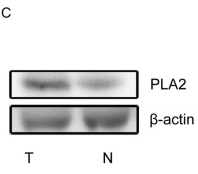PLA2G2A Antibody - #DF6366
| Product: | PLA2G2A Antibody |
| Catalog: | DF6366 |
| Description: | Rabbit polyclonal antibody to PLA2G2A |
| Application: | WB IHC IF/ICC |
| Cited expt.: | WB, IF/ICC |
| Reactivity: | Human, Mouse, Rat |
| Prediction: | Pig, Horse, Rabbit |
| Mol.Wt.: | 16kDa; 16kD(Calculated). |
| Uniprot: | P14555 |
| RRID: | AB_2838330 |
Related Downloads
Protocols
Product Info
*The optimal dilutions should be determined by the end user. For optimal experimental results, antibody reuse is not recommended.
*Tips:
WB: For western blot detection of denatured protein samples. IHC: For immunohistochemical detection of paraffin sections (IHC-p) or frozen sections (IHC-f) of tissue samples. IF/ICC: For immunofluorescence detection of cell samples. ELISA(peptide): For ELISA detection of antigenic peptide.
Cite Format: Affinity Biosciences Cat# DF6366, RRID:AB_2838330.
Fold/Unfold
EC 3.1.1.4; GIIC sPLA2; Group IIA phospholipase A2; membrane associated; MOM1; Non pancreatic secretory phospholipase A2; Non-pancreatic secretory phospholipase A2; NPS PLA2; NPS-PLA2; NPSPLA2; PA2GA_HUMAN; Phosphatidylcholine 2 acylhydrolase; Phosphatidylcholine 2-acylhydrolase 2A; Phospholipase A2; Phospholipase A2 group IIA (platelets synovial fluid); Phospholipase A2 membrane associated precursor; PLA2; PLA2B; PLA2G2A; PLA2L; PLA2S; PLAS1; RASF A; RASFA; sPLA2;
Immunogens
A synthesized peptide derived from human PLA2G2A, corresponding to a region within the internal amino acids.
- P14555 PA2GA_HUMAN:
- Protein BLAST With
- NCBI/
- ExPASy/
- Uniprot
MKTLLLLAVIMIFGLLQAHGNLVNFHRMIKLTTGKEAALSYGFYGCHCGVGGRGSPKDATDRCCVTHDCCYKRLEKRGCGTKFLSYKFSNSGSRITCAKQDSCRSQLCECDKAAATCFARNKTTYNKKYQYYSNKHCRGSTPRC
Predictions
Score>80(red) has high confidence and is suggested to be used for WB detection. *The prediction model is mainly based on the alignment of immunogen sequences, the results are for reference only, not as the basis of quality assurance.
High(score>80) Medium(80>score>50) Low(score<50) No confidence
Research Backgrounds
Catalyzes the calcium-dependent hydrolysis of the 2-acyl groups in 3-sn-phosphoglycerides. Thought to participate in the regulation of phospholipid metabolism in biomembranes including eicosanoid biosynthesis. Independent of its catalytic activity, acts as a ligand for integrins. Binds to and activates integrins ITGAV:ITGB3, ITGA4:ITGB1 and ITGA5:ITGB1. Binds to a site (site 2) which is distinct from the classical ligand-binding site (site 1) and induces integrin conformational changes and enhanced ligand binding to site 1. Induces cell proliferation in an integrin-dependent manner.
Cell membrane>Peripheral membrane protein. Secreted.
Belongs to the phospholipase A2 family.
Research Fields
· Environmental Information Processing > Signal transduction > Ras signaling pathway. (View pathway)
· Metabolism > Lipid metabolism > Glycerophospholipid metabolism.
· Metabolism > Lipid metabolism > Ether lipid metabolism.
· Metabolism > Lipid metabolism > Arachidonic acid metabolism.
· Metabolism > Lipid metabolism > Linoleic acid metabolism.
· Metabolism > Lipid metabolism > alpha-Linolenic acid metabolism.
· Metabolism > Global and overview maps > Metabolic pathways.
· Organismal Systems > Circulatory system > Vascular smooth muscle contraction. (View pathway)
· Organismal Systems > Digestive system > Pancreatic secretion.
· Organismal Systems > Digestive system > Fat digestion and absorption.
References
Application: IF/ICC Species: Rat Sample: HPCs
Application: WB Species: Human Sample:
Restrictive clause
Affinity Biosciences tests all products strictly. Citations are provided as a resource for additional applications that have not been validated by Affinity Biosciences. Please choose the appropriate format for each application and consult Materials and Methods sections for additional details about the use of any product in these publications.
For Research Use Only.
Not for use in diagnostic or therapeutic procedures. Not for resale. Not for distribution without written consent. Affinity Biosciences will not be held responsible for patent infringement or other violations that may occur with the use of our products. Affinity Biosciences, Affinity Biosciences Logo and all other trademarks are the property of Affinity Biosciences LTD.



